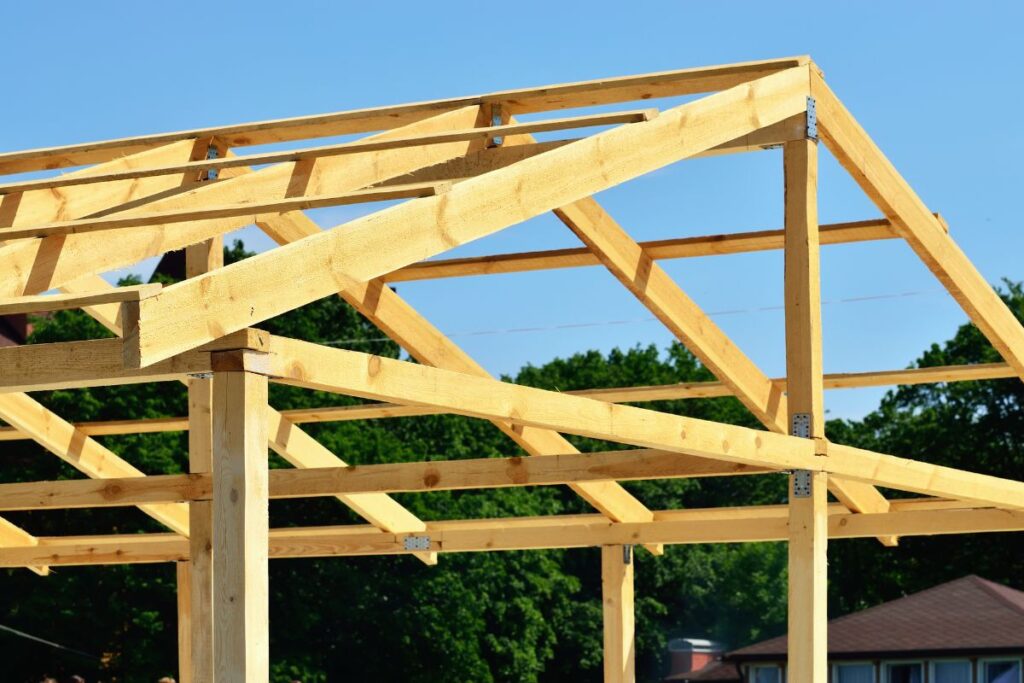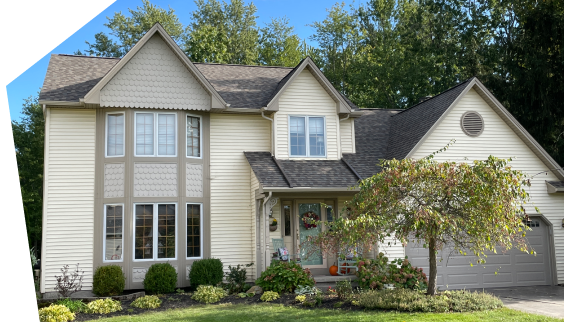Having an efficient, stylish, and eco-friendly home design is a top priority for many homeowners in 2025. One important decision homeowners and builders face is choosing between rafters and trusses for the roof structure. While both support the roof, they impact the look, construction process, and long-term performance of a home in different ways.
If you’re planning a new build or a major roof renovation, understanding the difference between rafters vs. trusses can help you make the right choice and get the most out of your roof design in 2025.
What Is A Rafter?

A rafter is a key part of roof construction, typically made from wood or steel, and forms the sloped framework that gives the roof its shape. It stretches from the ridge board at the peak down to the wall plate on top of the building’s walls. Rafters are spaced evenly to support the roof’s weight and create a solid base for materials like shingles or tiles.
They also play a crucial role in transferring the roof’s load to the walls, helping the structure stay strong against wind, snow, and other forces. Since rafters are usually built on-site, they offer more flexibility in design and can be easily adjusted during construction, making them a great choice for custom roof shapes.
| PROS | CONS |
| Custom Fit: Can be cut on-site to match any roof design. | Higher Cost: Needs skilled labor, making it pricier. |
| More Space: Allows for vaulted ceilings or attic areas. | Takes Time: On-site cutting slows down the build. |
| Energy Saving: Easy to insulate between beams. | Needs Skill: Requires experienced professionals. |
| Stylish Look: Exposed rafters add a rustic or modern touch. | Less Support: Can’t span as far or hold as much as trusses. |
What Are Trusses?

Roof trusses are pre-built structural frameworks designed to support the weight of a roof and transfer it to the building’s load-bearing walls or supports. Usually shaped like triangles, they’re made from wood or steel and include connected parts like beams, posts, and struts.
Trusses help keep the roof stable by evenly spreading out the load, making them a reliable choice for different roof styles, including sloped roofs for areas with heavy rain or snow. Because of their strength, versatility, and efficiency, roof trusses are commonly used in homes, commercial spaces, and industrial buildings.
| PROS | CONS |
| Cost-Effective: Uses less material and cuts down on labor. | Less Customization: Prefabricated shapes may not fit unique designs. |
| Strong & Stable: Handles wind, snow, and heavy loads well. | Hard to Transport: Large size can be tricky to move. |
| Long-Lasting: With care, they stay strong for years. | Needs Maintenance: Regular checks help avoid moisture damage. |
| Fast to Install: Prefabricated design speeds up construction. | Higher Steel Cost: Steel trusses cost more upfront than wood. |
What Is The Difference Between Rafters And Trusses?
To better understand which one suits your project, below are the main differences between rafters and trusses.
#1. Fabrication Process
Rafters are constructed on-site from dimensional lumber, offering design flexibility but requiring more labor and time. This method relies heavily on skilled carpenters and leaves room for human error during cutting and assembly. In comparison, trusses are built off-site using precision machinery. Their prefabrication ensures consistent quality and allows for quicker, smoother installation once delivered to the job site.
#2. Strength and Weight Distribution
Trusses vs. rafters’ load-bearing capacity is one of the biggest factors to consider. Unlike roof rafters, which use wider boards and create open spans, trusses rely on triangular webbing made from smaller planks. This geometric design distributes weight more evenly across the structure, offering greater strength and resistance to environmental stresses like wind or snow. Rafters can still perform well but may need added supports in larger builds, increasing complexity.
#3. Cost
The cost of rafters vs. trusses is often a deciding factor in project planning. Opting for rafters usually involves higher expenses due to the need for skilled labor, longer construction times, and potential for material waste. Meanwhile, trusses reduce labor costs and installation time, making them a more budget-friendly option for many projects. Though shipping trusses for roof framing can be costly in remote areas, they often remain the more affordable choice overall.
#4. Design Flexibility
One of the main advantages of rafters is their ability to accommodate custom designs. They’re ideal for vaulted ceilings, unique rooflines, and projects where on-site adjustments are needed. Truss roof designs, however, follow standardized shapes that limit post-installation changes. While they can be engineered for certain customizations, their flexibility is generally more restricted.
#5. Installation Speed
Building with roof rafters often extends the construction timeline, as each piece is measured and assembled on-site. On the other hand, trusses are delivered ready to install, often allowing an entire roof structure to be completed in a single day with the help of cranes. This accelerates the construction schedule and helps avoid delays, which is why many builders prefer trusses for roof installation.
#6. Space Utilization
With rafters, the space beneath the roof remains mostly open, making it easier to include attics or vaulted ceilings in the design. Trusses, in contrast, fill the roof cavity with webbing, limiting usable attic space. Though certain types of attic truss roof designs exist, rafters typically offer more freedom for interior expansion.
#7. Suitability
Custom homes, remodels, or remote builds often benefit more from rafters, as their on-site adaptability fits unique or complex designs. Conversely, trusses shine in new construction projects where uniformity, strength, and speed are critical. Their reliability and efficiency make them ideal for subdivisions, commercial buildings, and large-scale housing developments.
#8. Maintenance and Repair
Accessing and repairing rafter-based roof systems is typically easier due to their open structure. This allows for better ventilation and straightforward maintenance. In contrast, trusses, while more durable and requiring less frequent upkeep, are harder to navigate during inspections or repairs due to their tight, enclosed framework.
#9. Code Compliance
Meeting building codes can be more involved with rafters, since they are custom-built and may need additional inspection and documentation. Trusses, on the flip side, are engineered and often pre-approved to meet code requirements, streamlining the approval process and reducing delays during construction.
#10. Aesthetic Appeal
Interior spaces with rafter systems often benefit from their visual charm, especially when beams are left exposed for rustic or architectural appeal. Trusses usually lack this aesthetic quality and are hidden behind ceilings. That said, some modern designs intentionally showcase exposed trusses as part of an industrial or contemporary style.
#11. Durability and Longevity
Thanks to their engineered structure, trusses tend to last longer and hold up better against environmental forces over time. Rafters are still durable but depend more on craftsmanship and regular maintenance. Over the long term, trusses may require fewer repairs and offer greater structural integrity.
Roof Rafters vs. Trusses: Which One Is Better?
Trusses and rafters both have their benefits, depending on your project. Trusses are pre-made, less expensive, and quick to install, great for new homes and wide roofs that don’t need extra support inside. They cost less and can be set up in a day, but aren’t as flexible for custom designs. Rafters are built on-site, which makes them better for unique roof styles like vaulted ceilings or attic spaces. They take more time and money but work well for older homes or custom projects. Your choice depends on whether you need speed and savings or more design flexibility.
Secure Your Home with OConnor Contracting’s Roofing Services
When it comes to expert roof design and installation, OConnor Contracting is the name you can rely on. We are known for providing the best roofing services, with expertise in both rafter and truss systems. Whether you’re building something new or updating an existing structure, our experienced team of roofers will guide you every step of the way. Using only high-quality materials, we ensure your roof is built to last. Contact us today at (716) 600-7663 for roofing services you can count on.


